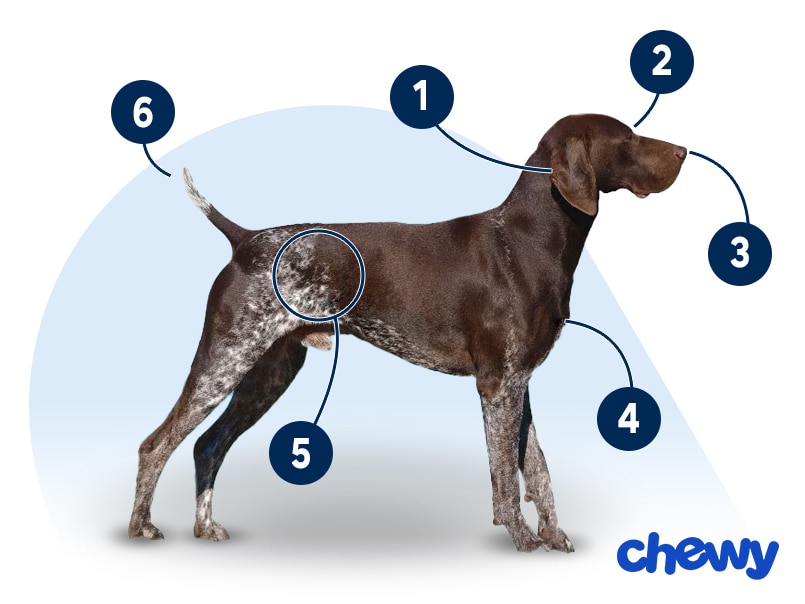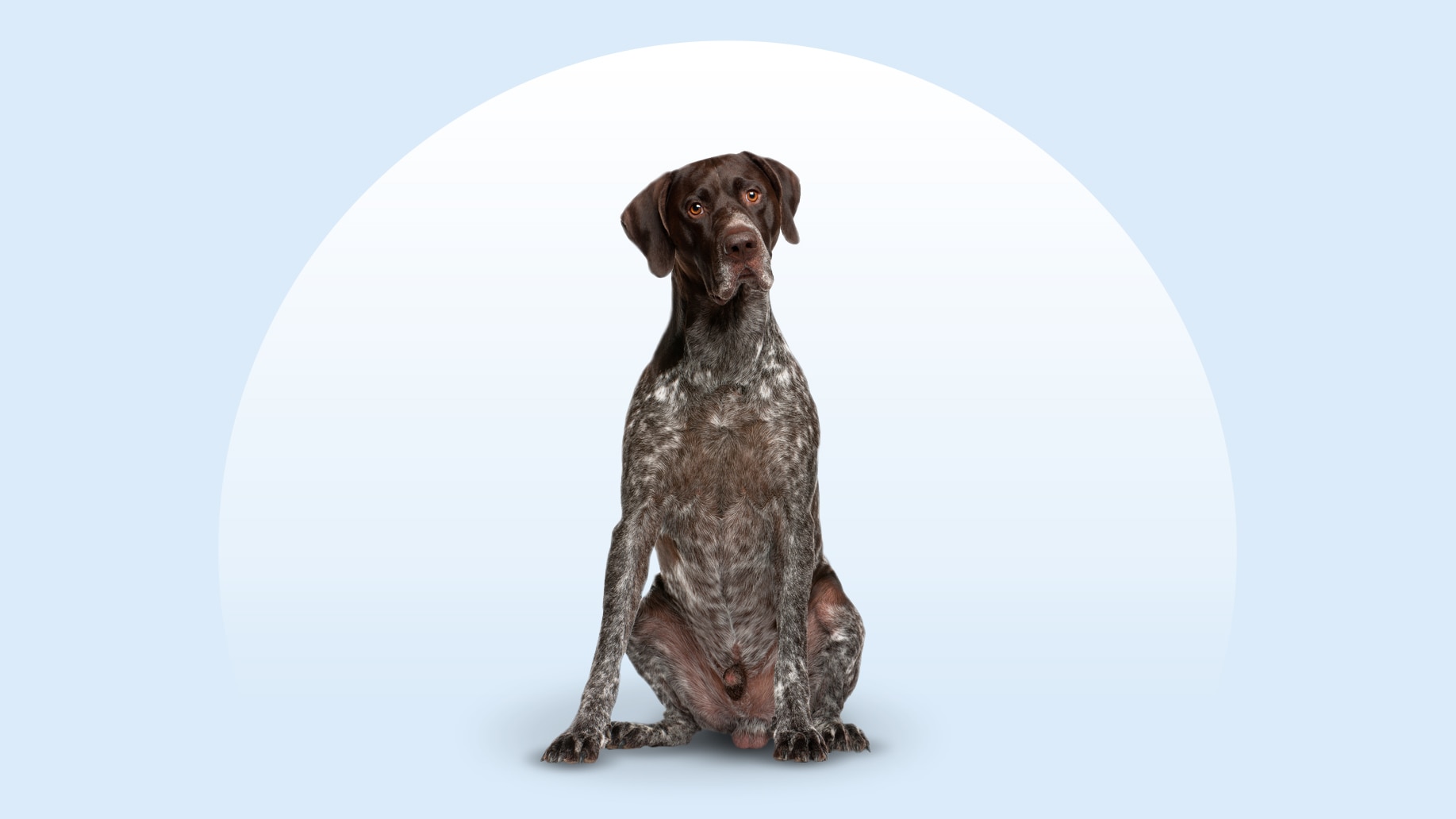German Shorthaired Pointer
Updated December 15, 2025
German Shorthaired Pointer
Updated December 15, 2025
The German Shorthaired Pointer thinks there’s only one thing better than being on the go, and that’s being on the go with you, their favorite person. These energetic pups will thrive with a pet parent who’s equally as sporty and wowed by the natural world.
Active, Energetic, Loyal
45–70 pounds
21–25 inches
10–12 years
Black, Black and White, Black Roan, Liver, Liver and White, Liver Roan, White and Liver
Are you a Type A personality who’s up at dawn to make your 8 a.m. hike? If that schedule doesn’t make your head spin, the German Shorthaired Pointer might be your soul pup.
This active dog loves the thrill of adventure and sees absolutely no need to slow down when there’s just so much to see in the world. Even past their puppy stage, GSP dogs have an energy that requires a very special human to keep up with.
German Shorthaired Pointer Characteristics
German Shorthaired Pointer Appearance
German Shorthaired Pointers, commonly called GSPs, have alert, brown eyes and short, often spotted coats. Their floppy ears add a touch of whimsy as they dash toward you.

- Ears
Their floppy ears are set somewhat high on their head.
- Eyes
Their almond-shaped eyes are dark brown.
- Nose
The typical German Shorthaired Pointer nose is brown and large, with a long muzzle.
- Coat Length
The GSP coat is short and coarse.
- Coat Color
German Shorthaired Pointer colors vary, but the breed is often liver (brown) with white markings. Their coat may also be solid liver, black, black and white, black roan (an even mix of colors), and liver roan, and might include patches or ticking (small spots or flecks of color on white fur).
- Tail
While it was once common to dock a German Shorthaired Pointer’s tail, nowadays many of these pups have their tail intact. Many groups, including the American Veterinary Medical Association, oppose tail docking, and many countries as well as U.S. states have banned the practice.
German Shorthaired Pointer Temperament
The German Shorthaired Pointer breed is a loyal, loving dog who wants to hang out with their pet parent and keep busy. These dogs need to have something to do nearly 24/7, and you’ll find they’re alert pups who keep an eye—and a very strong nose—on everything.
Despite their very busy schedule, they’re easygoing when it comes to meeting new people and tend to be friendly with everyone, including other dogs. There are always exceptions, but many German Shorthaired Pointers won’t thrive in a home with smaller pets, like a cat. (No offense, felines—it’s not personal, it’s just their hardwired hunting instincts.)
GSPs are recognized as one of the smartest dog breeds. Because of this, around-the-clock mental stimulation is a must to prevent boredom, so keep your dog busy with outdoor adventures, puzzle toys, interactive playtime, and frequent training sessions.
How to Care for a German Shorthaired Pointer
German Shorthaired Pointers are easy to groom, so you’ll spend the bulk of your time on other matters (namely, training, exercising, and playing).
Grooming
Training
Diet
Exercise
Environment
German Shorthaired Pointer Health
The typical German Shorthaired Pointer lifespan is 10–12 years. Here are some health issues to be aware of.
- Bloat and gastric dilatation-volvulus (GDV): German Shorthaired Pointers, like many large, deep-chested breeds, are prone to a life-threatening condition called bloat when the stomach distends with air and/or food. A serious complication of bloat is gastric dilatation-volvulus, when the stomach twists on itself, cutting off blood supply to the organs. Symptoms include abdominal distension, restlessness, excessive drooling, and dry heaving. Go to the vet immediately if you notice signs of bloat and GDV.
- Elbow and hip dysplasia: Elbow and hip dysplasia are genetic conditions when the joints don’t align well and become looser than normal. Signs include limping, and treatment might involve weight loss, reduced activity, joint supplements, physical therapy, pain meds, or (in severe cases) surgery.
- Hypothyroidism: Hypothyroidism is a common condition that includes symptoms like lethargy, hair loss, ear and skin infections, and weight gain. A blood test can diagnosis it, and treatment is a daily oral medication.
- Von Willebrand disease: GSP pups are susceptible to von Willebrand disease, a bleeding disorder where the blood doesn’t clot properly. Your veterinarian can test your dog for this.
German Shorthaired Pointer History
The German Shorthaired Pointer originated in Germany in the 18th and 19th centuries, according to the German Shorthaired Pointer Club of America. They were originally bred as hunting dogs—specifically, as bird dogs.
The breed arrived in the U.S. in the 1920s, and the American Kennel Club (AKC) recognized the German Shorthaired Pointer in the 1930s. Today, the breed is one of the most popular dog breeds in the U.S.
German Shorthaired Pointer puppies are usually $800–$2,000. If you choose this route, pick a responsible breeder.
You can also consider German Shorthaired Pointer adoption. Look for a local German Shorthaired Pointer rescue, like the German Shorthair Pointer Rescue Pennsylvania; keep an eye out at your local animal shelter; or search Chewy’s database of adoptable dogs in your area.








